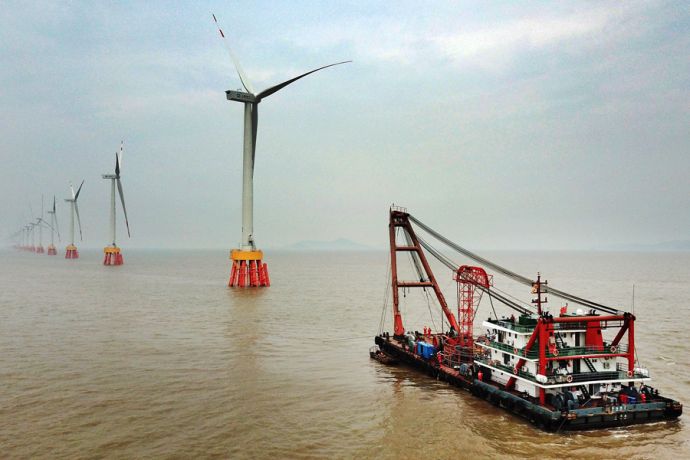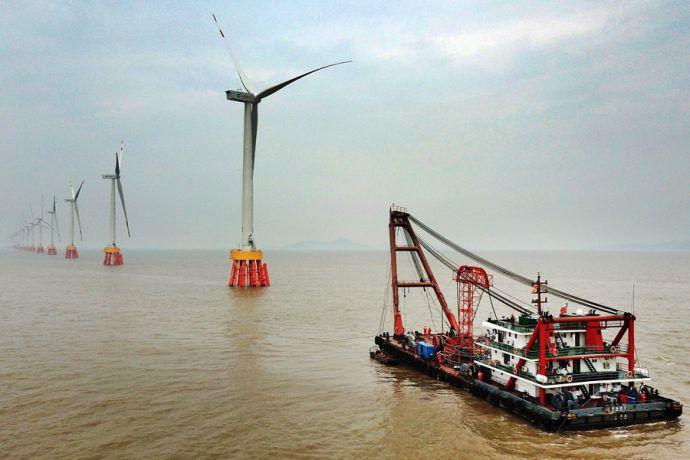
BEIJING -- Three homemade typhoon-resistant offshore wind turbines, among the world's most powerful, have been running at full power since mid-May in Xinghua Gulf, East China's Fujian province.
The turbines, with their 76.6-meter-long blades, each has a capacity of 7 megawatts, and their development cost 2.3 billion yuan ($358 million), according to Mingyang Smart Energy, the manufacturer.
The turbines are working well, said Zhang Qiying, chief technology officer of the company based in Zhongshan, Guangdong province.
As China promotes green development, clean energy-including wind, solar and nuclear power-is thriving in the country, reducing dependence on coal.
The National Energy Administration said the total installed renewable energy capacity reached 650 million kilowatts by 2017, up 14 percent from 2016. Clean energy generated 1.7 trillion kWh of electricity last year, accounting for 26.4 percent of the country's total.
China's southeastern coastal areas see low wind speeds, but many typhoons, which differs from Europe, which has abundant wind energy sources, Zhang said.
"Therefore, we need to address the problems brought by typhoons, while utilizing them to raise the efficiency of our wind turbines," he said.
According to the Global Wind Energy Council, China ranked third in terms of total installed capacity of offshore wind turbines, accounting for 11 percent of the world's total, as of the end of 2016, after Britain and Germany.
Since 2017, several coastal provinces have released their development plans for offshore wind power, with a total installed capacity exceeding 100 million kilowatts.
Guangdong plans to build 23 offshore wind farms before 2030. Their total installed capacity will hit 66.85 million kilowatts, three times that of the Three Gorges hydropower station.
A group of wind turbines with a total installed capacity of 100 megawatts in the sea off Guangdong's Zhuhai will begin operation by the end of this year. The equipment can alleviate the power shortages in nearby islets.
In China, the capacity of an offshore wind turbine is 1.5 to 2 times that of those inland. The new-generation wind turbines being developed are expected to have a capacity quadruple that of a turbine based inland.
The rapid development of China's offshore wind energy industry is expected to form an industrial chain of high-end offshore equipment with a value of 1 trillion yuan, said Chen Sui, chairman of CGN Energy Holdings Co, Ltd.
More importantly, China has complex conditions of ocean currents and seabed geology, and is prone to typhoons, Chen said. "Our technology that can handle these challenges is hopefully a cheaper option of clean energy for the world."
The solar and nuclear power sectors in the country have also witnessed fast growth in recent years. Since China announced its plans to support distributed solar power generation in 2012, solar panels have been mushrooming on residents' roofs, with unused generated power integrated into the national power grid.
Statistics show that China's installed solar power capacity was nearly 30 million kilowatts by 2017, and is expected to exceed 160 million kilowatts by 2020, accounting for nearly 10 percent of the country's total installed electricity capacity.
As of November, China had 37 operational nuclear reactors and is building a further 19 more such facilities.
Total installed nuclear power capacity in operation was nearly 36 million kilowatts, ranking fourth worldwide. The volume is expected to reach 58 million kilowatts by 2020, with the number of nuclear reactors under construction leading the world for many years.
The country's clean energy endeavor has paid off.
Due to the proliferation of clean energy of various kinds, coal consumption, a major contributor to the country's air pollution, has reduced by 8.1 percent over the past five years, according to official statistics.
A report released by the International Energy Agency in October said China alone was responsible for more than 40 percent of global renewable capacity growth in 2016, making it the undisputed renewable growth leader. (Source:China Daily)




 A single purchase
A single purchase









